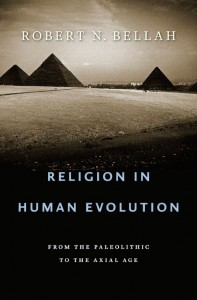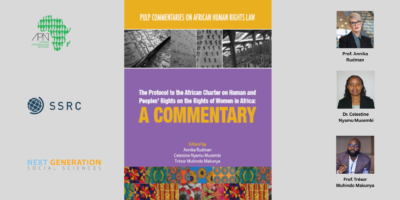 To be asked to contribute a commentary on Professor Robert Bellah’s magnum opus is a great honor and a privilege that, in the virtual company of intellectuals of the highest caliber, manages to concentrate the mind and at the same time to fill you with despair; not least because Religion in Human Evolution stands as a measure of the distance that lies between routine, or ordinary, intellectual activity, and genuine, indeed extraordinary, intellectual achievement. In a single stroke Religion in Human Evolution offers a new perspective on religion and its significance in human history, renews evolutionary theory, and places struggle for “meaning” in the core of sociological analysis, as an alternative to Weberian “power” and Marxian “freedom” as the steam-engines of social change.
To be asked to contribute a commentary on Professor Robert Bellah’s magnum opus is a great honor and a privilege that, in the virtual company of intellectuals of the highest caliber, manages to concentrate the mind and at the same time to fill you with despair; not least because Religion in Human Evolution stands as a measure of the distance that lies between routine, or ordinary, intellectual activity, and genuine, indeed extraordinary, intellectual achievement. In a single stroke Religion in Human Evolution offers a new perspective on religion and its significance in human history, renews evolutionary theory, and places struggle for “meaning” in the core of sociological analysis, as an alternative to Weberian “power” and Marxian “freedom” as the steam-engines of social change.
To establish this alternative perspective, Bellah develops a very distinctive understanding of the evolutionary process, which he traces back in pre-human, and indeed pre-primate, speciation to arrive at the ascent of critical thinking as it first crystallized in the axial age. In an original sociological reading of ethology and evolutionary biology, Bellah establishes a causal-evolutionary model that begins with the active participation of various life forms in species complexity (rather than species specialization), then moves to mammalian play, empathy, and ritual, and culminates in the primate “episodic” and the uniquely human “mimetic,” “mythic,” and “theoretic” stages of cultural evolution.
Bellah’s grand argument is complex but elegant: social cohesion constitutes, simultaneously, a functional mechanism for group survival and an incubator of more complex forms of social evolution; these various forms of social cohesion, in a certain evolutionary stage of social development, crystallized in institutional “religion”; religion became a generalized means of generating social capacities that increase in every new stage of cultural evolution; failing to develop such patterns (a very real possibility) means the neutralization of the evolutionary process itself; and religion, even in its most domineering forms, entails moral reflexivity and social criticism, based upon the crucial distinction between reciprocal hierarchies and brute exercise of domination. In a nutshell, Religion in Human Evolution is a story of life on Earth stretching itself to consciousness as a product of “relaxed fields” of alternative realities sheltered from the struggle for survival; first interspecific, then species-specific, and eventually intraspecific. I cannot help but think of Robert Bellah having turned Teilhard de Chardin on his head.
The originality, depth, and cross-disciplinary nature of the book is bound to trigger a series of controversies as well as original research programs limited only by the intellectual background and imagination of the reader. I will not dwell on this matter, as other scholars more competent than me have already done so on this website. I only wish to point to some definite accomplishments I believe the book has already made, the impact of which will be deep and lasting.
First, the book has challenged the monopoly sociobiology and militant naturalism alike hold on evolutionary theory. Since E. O. Wilson’s Sociobiology: the New Synthesis and Richard Dawkins’s The Selfish Gene, a rift in the midst of human studies is lurking deep. On the one side stand those who scorn the sacred, spiritual, or religious aspects of social life as various forms of a grand illusion; on the other side, those who claim that evolution does not apply to humankind since we have escaped its “red in tooth and claw” and we are masters of our fate. Religion in Human Evolution does not operate as a bridge between them; rather, it transcends the whole debate by introducing, and bringing into the heart of sociology, a developmental understanding of evolution that depends on the principle of play rather than competition and leads to increased complexity rather than specialization. Bellah exposes us to a much more balanced view of the natural process as a dialectic of necessity and freedom that is able to offer a valid scientific hypothesis of not only how the flesh multiplied, but also how the flesh (eventually) became spirit.
The second accomplishment is nothing less than the detailed and meticulous philological description of the birth of axial thinking itself. To follow Bellah’s guiding light, as it leads the reader through a vast labyrinth of ancient texts to demonstrate, for the first time, the actual ways that mythos became logos, is as pleasurable as it is intellectually rewarding. It delineates the presence of both the indispensable contribution of pre-axial literacy and the sudden eruption of creativity. As I see it, Bellah in one stroke solves the riddle of the “sudden appearance” of axial thinking and offered four case studies of the merging of mimetic, mythic, and theoretical culture. In effect, he provides a strong case for the evolutionary power of society—that new social capacities for organization, cohesion, and mobilization can be mastered only in a process of accumulation; and that the more we move to more complex forms of social organization, the more the individual becomes necessary to provide society with new impetus to push history forward.
The last two accomplishments of the book become evident when we compare its logic with the neo-Marxist and neo-Weberian grand narratives that have monopolized the field of grand historical sociology for the last forty years. The 1970s witnessed a strong revival of Marxism, which was followed by thirty years of a “neo-Weberian revolution,” incorporating a strong dose of Marxist conflict analysis, which until today rules the discipline. The hegemony of the two perspectives, irrespective of their interchangeability or particulars, have established certain assumptions about religion and the nature of historical change—that is, underlying suppositions of the nature of social change in toto.
First, on religion: Both neo-Marxist and neo-Weberian grand narratives tend to downplay or even ignore religion as they reduce it to its political and organizational features and neglect its ideational side. Bellah restores religion to its former glory, not by reminding the reader of its Durkheimian or Weberian features, but by locating it in a wider framework of an endless quest for meaning and alternative perceptions of reality. In this context, religion becomes the key to understanding social evolution (at least up to modernity), since religion and its concomitant practices are the means to firmly establish increasingly complex social power arrangements and structures that otherwise would be unattainable. For Bellah, religion is a generalized means of social action: as religion derives from the relaxed field of play (not “functional” itself), it remains, even in its most institutional forms, a bridge between necessity and freedom, between actual and potential forms of social life, and thus a privileged locus for social criticism and new visions of social organization and justice.
Second, on the suppositions of historical change and the fate of society itself: Neo-Marxist grand narratives tend to be teleological and moralistic, producing reductionist visions of social change and utopian outcomes. On the contrary, neo-Weberian grand narratives are cynically realistic and develop anti-teleological views of historical change that come close to declaring social evolution meaningless, blindly walking (or even bouncing back) through the corridors of history as if guided by accidents, unintentional consequences, and perilous passions. Considering the post-1980s demise of neo-Marxist grand theory, all that is left to us today is the hegemony of this neo-Weberian cynicism and pessimism.
Robert Bellah’s Religion in Human Evolution comes to counter this cynicism and pessimism in a most forceful way; and it does so in spite of the open pessimism and cynicism of the author himself, who in the concluding chapter of his book declares that we are in fact an insignificant and short-sighted species that is driving the planet to extinction. There is nothing in the book that prepares you for this conclusion, and rightly so. True as it is that Bellah is very careful to avoid teleological arguments—and his evolutionary scheme always allows for alternative paths, even dead-ends—reading the book unfolds a magisterial hopeful, if not optimistic image of an unbroken pathway that life on Earth has taken to self-reflection, awareness, and eventually an ecumenical sense of justice. And this is persuasively presented as the natural, though fortuitous, outcome of propensities latent in the evolutionary paths opened first by simple life forms, then by the “relaxed fields” of mammalian social life, and realized when we arrived at contemplation by self-reflecting individuals—“nothing is ever lost.” It is in this evolutionary context that Bellah investigates the emergence of axial thinking that is still with us today; in fact, an equally proper title of the book, though I admit, provocative in extremis, would be Human Evolution in Religion.
Thus, the book might be more controversial, and not as straight forward as, for example, Michael Mann’s Sources of Social Power, John Hall’s Powers and Liberties, or W. G. Runciman’s A Treatise on Social Theory, but its “looseness” is its power: more imaginative, more provocative, and more suggestive. Perhaps in part this might be explained by the fact that this masterpiece was written not under normal academic pressure, but in the relaxed field of honorable retirement.












Can I recommend David Graeber’s Debt: The First 5000 years as another book that helps you understand the role played by religious thought and organized religion in the past few thousand years of history? (It might serve to complement the arguments presented by Bellah, which, if this review is any indication, might be a bit too cerebral.)